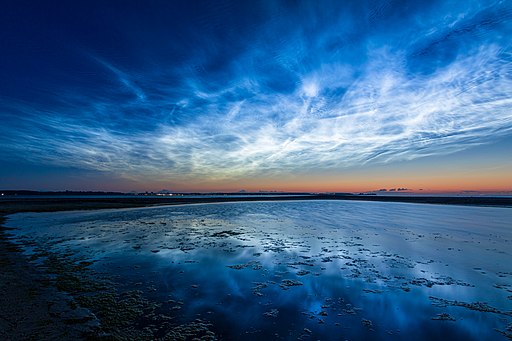The stratosphere is the atmospheric layer above the troposphere, known for containing the ozone layer, while the troposphere is the lowest layer where weather occurs.
TL;DR Stratosphere Vs. Troposphere
The troposphere, being the lowest layer of the atmosphere, is where most of our weather occurs. It extends from the Earth’s surface up to an average altitude of about 12 kilometers (7 miles). This dynamic layer contains water vapor, clouds, and all forms of precipitation. It also experiences a decrease in temperature with increasing altitude.
Above the troposphere lies the stratosphere. Stretching from approximately 12 to 50 kilometers (7 to 31 miles) above sea level, this region has some unique features that distinguish it from its lower counterpart. One key characteristic is its stable stratification due to a temperature inversion caused by ozone absorption of ultraviolet radiation.
What is Stratosphere?

The stratosphere is a layer of the Earth’s atmosphere located above the troposphere, extending approximately 10 to 50 kilometers above sea level. It may not be as well-known as its lower counterpart, but it holds significant importance in our understanding of atmospheric dynamics.
One distinguishing feature of the stratosphere is its composition. This region contains a high concentration of ozone molecules, which form the ozone layer. Acting like a shield, this protective layer absorbs most of the Sun’s harmful ultraviolet (UV) radiation and prevents it from reaching the Earth’s surface.
In the stratosphere temperatures actually rise due to absorption of UV radiation by ozone molecules. This unique characteristic creates stability within this upper atmospheric layer.
Another fascinating aspect of the stratosphere is its influence on weather patterns. While most weather phenomena occur in the troposphere, certain events happening here can indirectly impact conditions down below. For example, large volcanic eruptions inject massive amounts of particles into stratospheric levels which can alter global climate for months or even years!
What is Troposphere?

The troposphere is the layer of the Earth’s atmosphere that is closest to its surface. It extends approximately 8-15 kilometers above sea level, although this height can vary depending on factors such as location and weather conditions. This layer plays a crucial role in our everyday lives as it is where weather phenomena occur.
One of the key characteristics of the troposphere is its temperature profile. As you move upward from the Earth’s surface, the temperature decreases at a rate of about 6.5 degrees Celsius per kilometer. This lapse rate creates convection currents that drive weather patterns by causing warm air to rise and cooler air to sink.
Another important feature of the troposphere is its composition. It contains most of the Earth’s atmospheric gases, including nitrogen, oxygen, carbon dioxide, and water vapor. These gases interact with each other and with solar radiation to create weather conditions such as rain, snow, clouds, and storms.
In addition to being responsible for weather phenomena, the troposphere also supports life on Earth. It provides us with breathable air and acts as a buffer against harmful ultraviolet radiation from the sun.
Stratosphere Vs. Troposphere – Key differences
| Aspect | Stratosphere | Troposphere |
|---|---|---|
| Location | Above the troposphere, starting at about 10-15 kilometers (6-9 miles) above the Earth's surface and extending up to about 50 kilometers (31 miles). | The lowest layer of Earth's atmosphere, extending from the Earth's surface up to an average altitude of about 8-15 kilometers (5-9 miles). |
| Temperature Trend | Temperature generally increases with altitude due to the presence of the ozone layer, known as the stratopause. | Temperature generally decreases with altitude at an average rate of about 6.5°C per kilometer (3.5°F per 1,000 feet). |
| Weather and Clouds | Relatively stable and dry; minimal weather events. Jet streams, including the ozone layer, are located here. | Contains most weather phenomena, such as clouds, precipitation, thunderstorms, and weather patterns. |
| Ozone Layer | Contains the ozone layer, which absorbs and scatters ultraviolet (UV) radiation from the Sun, protecting life on Earth from harmful UV rays. | Lacks the ozone layer, making it more exposed to harmful UV radiation. |
| Human Activity | Aircraft and weather balloons operate within the stratosphere. | Most commercial aviation and weather observations occur in the troposphere. |
| Jet Streams | Contains the polar jet stream and subtropical jet stream, influencing atmospheric circulation patterns and weather systems. | Jet streams are primarily located in the troposphere, including the polar jet stream and subtropical jet stream. |
| Air Composition | Air composition is similar to the troposphere, with nitrogen and oxygen being the dominant gases. | Similar air composition to the stratosphere, with nitrogen and oxygen as the primary gases. |
Characteristics of the Troposphere
- Lowest Atmospheric Layer: The troposphere is the lowest layer of Earth’s atmosphere, extending from the Earth’s surface up to an average altitude of about 8-15 kilometers (5-9 miles), depending on the latitude and season.
- Temperature Decrease with Altitude: As you ascend through the troposphere, temperature generally decreases with altitude at an average rate of about 6.5°C per kilometer (3.5°F per 1,000 feet). This temperature gradient is known as the lapse rate.
- Weather and Cloud Formation: The troposphere is where most weather phenomena occur. It is characterized by the presence of clouds, precipitation, thunderstorms, and various weather patterns due to its proximity to the Earth’s surface and temperature fluctuations.
- Convective Mixing: Convection, the vertical movement of air masses, is a dominant process in the troposphere. Warm, less dense air rises, and cool, denser air sinks, leading to convective mixing and the formation of weather patterns.
- Human Activity and Aviation: Most of human activities, including aviation and weather observations, take place within the troposphere. Commercial aircraft typically operate in this layer, making it of great practical significance for transportation and meteorological studies.
Characteristics of the Stratosphere
- Ozone Layer: The stratosphere contains a region known as the ozone layer, which is characterized by a higher concentration of ozone (O3) molecules. This ozone layer absorbs and scatters a significant portion of the Sun’s harmful ultraviolet (UV) radiation, protecting life on Earth from the damaging effects of UV rays.
- Temperature Increase with Altitude: In contrast to the troposphere, where temperature generally decreases with altitude, the stratosphere experiences a temperature inversion. As one ascends through the stratosphere, temperatures typically increase with altitude, primarily due to the absorption of solar energy by ozone molecules.
- Dry and Stable: The stratosphere is relatively dry and stable compared to the troposphere below it. It contains very little water vapor, contributing to its stability and low likelihood of significant weather events or cloud formation.
- Jet Streams: The stratosphere hosts jet streams, including the polar jet stream and subtropical jet stream. These high-altitude, fast-moving air currents play a role in influencing atmospheric circulation patterns and can have downstream effects on weather systems in the troposphere.
- Limited Human Activity: While some aircraft, particularly commercial airliners, operate in the lower stratosphere, human activity in this layer is limited compared to the troposphere. Weather balloons equipped with instruments are used to collect atmospheric data in the stratosphere for research and meteorological purposes.
Image Credits
Featured Image By – NASA Earth Observatory, Public domain, via Wikimedia Commons
Image 1 By – Matthias Süßen, CC BY-SA 4.0 , via Wikimedia Commons
Image 2 By – Nick81aku at the English-language Wikipedia, CC BY-SA 3.0 , via Wikimedia Commons









